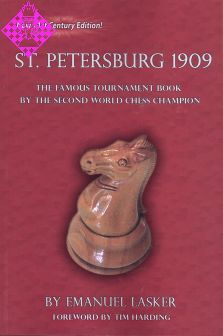Artikelnummer
LXLASSTP09RUS
Autor
St. Petersburg 1909
The Famous Tournament Book by the 2nd World Champi
190 Seiten, kartoniert, Russell Enterprises, 2008, original erschienen 1909
Vorübergehend ausverkauft
The Famous Tournament Book by the Second World Chess Champion
In February 1909, nineteen of the world's best chessplayers gathered in St. Petersburg to play in one of the most famous tournaments in chess history. World Champion Emanuel Lasker topped the list of competitors, which also included Akiva Rubinstein, considered by many to be Lasker's likely successor, Carl Schlechter, who would play one of the most famous matches against Lasker a year later, and many other of the "greats" of the era - Spielmann, Bernstein, Teichmann, Mieses and Tartakower, to name but a few.
One of the Great Chess Tournaments of All Time!
This is the official tournament book - available for the first time in English in algebraic notation - written by Emanuel Lasker. He annotated all 175 games in the clear, instructive style that would become his trademark.
The great 1909 International Chess Congress has long since taken its place among the greatest chess tournaments of all time. Now you may experience this 21st-century edition of Lasker's terrific tournament book.
ForewordThe international chess congress at St. Petersburg, Russia, was played early in 1909 at the cusp between two generations in the chess world. Chigorin and Pillsbury were no more; the rise of Alekhine and Capablanca was just over the horizon. The importance of the tournament is increased by the fact that it was the only one Dr. Emanuel Lasker (then the world champion) contested between CamSprings 1904 and the 1914 St. Petersburg event; he was concentrating on matches, exhibition tours, and non-chess activities. The tournament featured a duel between Lasker and the emerging talent, Akiva Rubinstein, which certainly made up for the absence of three men who challenged for the world title in the 1900s: Tarrasch, Janowski, and Marshall. The result encouraged Rubinstein to seek a title match himself, but unfortunately it never happened.
Several other masters of the new generation featured in the tournament but anfuture title challenger, Schlechter, failed in this event. There was no new generation of top-class British professionals, England being represented by Burn, the veteran amateur. Blackburne surprisingly only made his first visit to Russia for the 1914 event, at the age of 72. Richard Forster's biography of Burn menthat several of the westerners "may have experienced difficulties with the food and accommodation provided" and several masters were reported to have fallen ill during the three-week event.
The home contingent included players who lived in the Tsarist empire but were not really Russian (Salwe and Rubinstein) and the intended complement of ten was not fulfilled. Then Nenarokov withdrew after four rounds and his games were cancelled, creating a bye from round five onwards. His four games are, however, included in the book. Of the home contingent, Bernstein had the best result. Brilliancy prizes were awarded to Schlechter and Forgacs respectively for their wins against Salwe and Tartakower, so you may like to turn to those games first.
There was a tight race throughout between Lasker and Rubinstein. The latter had started with two wins. Lasker, facing him with black in round three, adopted a sharp but dubious variation against the Queen's Gambit, which was punished by Rubinstein's brilliant conception at moves 16-18. After losing to his rival, Lasker had a lot of ground to make up, but did so by the half-way mark. It is best to follow the leaders' progress through the event round by round in order to fully understand the tension. Rubinstein, because of the bye, was chasing through the second half until the penultimate round, when it was Lasker's turn to sit it out. The world champion found himself half a point behind going into the final round.
It is also noteworthy that Alekhine won the All-Russian championship, played simultaneously, earning the master title. For the first time the future world champion met famous players from abroad and could see them in action. His score of 13/16, a point ahead of Rotlewi and well clear of most of the field, included just two losses and two draws. Although most of the players that he beat are not well known, it should be noted that Karl Rosenkrantz, who gave up his place in the international to accommodate Perlis, scored only 9/16 in the All-Russian event, so the depth of quality in Russian chess was high even then.
The book includes all 175 games of the international tournament. The Ruy Lopez and Queen's Gambit were by far the most popular openings, as they would reuntil after the Second World War. There were only six Sicilians. The depth of annotations by today's standards may seem slight, but see Lasker's explanafor this in his preface. For example, in his Rubinstein epic, Lasker does not comment on every critical moment. Readers should analyse for themselves, for example, the possible consequences of 8.Bxf6!, which is analysed in modern books that include this game. Indeed one of the values of this book, especially for a player hoping to improve their game, is that it will turn up many situations, either in the actual play or Lasker's notes, where you can try to solve for yourself the unanswered questions that may arise when playing through a game.
Lasker's little-known book first appeared in Berlin in 1909, a few months after the tournament it describes. This translation (mostly by Teichmann, who finished sixth) was published in New York in 1910. The English edition has never previappeared in algebraic notation, so far as I am aware, so this is the first chance for most modern readers to appreciate a classic.
Tim Harding
Dublin
July 14, 2008
In February 1909, nineteen of the world's best chessplayers gathered in St. Petersburg to play in one of the most famous tournaments in chess history. World Champion Emanuel Lasker topped the list of competitors, which also included Akiva Rubinstein, considered by many to be Lasker's likely successor, Carl Schlechter, who would play one of the most famous matches against Lasker a year later, and many other of the "greats" of the era - Spielmann, Bernstein, Teichmann, Mieses and Tartakower, to name but a few.
One of the Great Chess Tournaments of All Time!
This is the official tournament book - available for the first time in English in algebraic notation - written by Emanuel Lasker. He annotated all 175 games in the clear, instructive style that would become his trademark.
The great 1909 International Chess Congress has long since taken its place among the greatest chess tournaments of all time. Now you may experience this 21st-century edition of Lasker's terrific tournament book.
ForewordThe international chess congress at St. Petersburg, Russia, was played early in 1909 at the cusp between two generations in the chess world. Chigorin and Pillsbury were no more; the rise of Alekhine and Capablanca was just over the horizon. The importance of the tournament is increased by the fact that it was the only one Dr. Emanuel Lasker (then the world champion) contested between CamSprings 1904 and the 1914 St. Petersburg event; he was concentrating on matches, exhibition tours, and non-chess activities. The tournament featured a duel between Lasker and the emerging talent, Akiva Rubinstein, which certainly made up for the absence of three men who challenged for the world title in the 1900s: Tarrasch, Janowski, and Marshall. The result encouraged Rubinstein to seek a title match himself, but unfortunately it never happened.
Several other masters of the new generation featured in the tournament but anfuture title challenger, Schlechter, failed in this event. There was no new generation of top-class British professionals, England being represented by Burn, the veteran amateur. Blackburne surprisingly only made his first visit to Russia for the 1914 event, at the age of 72. Richard Forster's biography of Burn menthat several of the westerners "may have experienced difficulties with the food and accommodation provided" and several masters were reported to have fallen ill during the three-week event.
The home contingent included players who lived in the Tsarist empire but were not really Russian (Salwe and Rubinstein) and the intended complement of ten was not fulfilled. Then Nenarokov withdrew after four rounds and his games were cancelled, creating a bye from round five onwards. His four games are, however, included in the book. Of the home contingent, Bernstein had the best result. Brilliancy prizes were awarded to Schlechter and Forgacs respectively for their wins against Salwe and Tartakower, so you may like to turn to those games first.
There was a tight race throughout between Lasker and Rubinstein. The latter had started with two wins. Lasker, facing him with black in round three, adopted a sharp but dubious variation against the Queen's Gambit, which was punished by Rubinstein's brilliant conception at moves 16-18. After losing to his rival, Lasker had a lot of ground to make up, but did so by the half-way mark. It is best to follow the leaders' progress through the event round by round in order to fully understand the tension. Rubinstein, because of the bye, was chasing through the second half until the penultimate round, when it was Lasker's turn to sit it out. The world champion found himself half a point behind going into the final round.
It is also noteworthy that Alekhine won the All-Russian championship, played simultaneously, earning the master title. For the first time the future world champion met famous players from abroad and could see them in action. His score of 13/16, a point ahead of Rotlewi and well clear of most of the field, included just two losses and two draws. Although most of the players that he beat are not well known, it should be noted that Karl Rosenkrantz, who gave up his place in the international to accommodate Perlis, scored only 9/16 in the All-Russian event, so the depth of quality in Russian chess was high even then.
The book includes all 175 games of the international tournament. The Ruy Lopez and Queen's Gambit were by far the most popular openings, as they would reuntil after the Second World War. There were only six Sicilians. The depth of annotations by today's standards may seem slight, but see Lasker's explanafor this in his preface. For example, in his Rubinstein epic, Lasker does not comment on every critical moment. Readers should analyse for themselves, for example, the possible consequences of 8.Bxf6!, which is analysed in modern books that include this game. Indeed one of the values of this book, especially for a player hoping to improve their game, is that it will turn up many situations, either in the actual play or Lasker's notes, where you can try to solve for yourself the unanswered questions that may arise when playing through a game.
Lasker's little-known book first appeared in Berlin in 1909, a few months after the tournament it describes. This translation (mostly by Teichmann, who finished sixth) was published in New York in 1910. The English edition has never previappeared in algebraic notation, so far as I am aware, so this is the first chance for most modern readers to appreciate a classic.
Tim Harding
Dublin
July 14, 2008
| Gewicht | 270 g |
|---|---|
| Hersteller | Russell Enterprises |
| Medium | Download, Buch |
| Erscheinungsjahr | 2008 |
| Autor | Emanuel Lasker |
| Sprache | Englisch |
| ISBN-13 | 9781888690460 |
| Jahr der Originalausgabe | 1909 |
| Seiten | 190 |
| Einband | kartoniert |
| Name | Russell Enterprises |
|---|---|
| Adresse | 234 Depot Road Milford, CT 06460 USA |
| Internet | www.Russell-Enterprises.com |
| hwr@russell-enterprises.com |
Verantwortlicher Importeuer:
| Name | Schachversand Niggemann |
|---|---|
| Adresse | Schadowstraße 5 48163 Münster Deutschland |
| info@schachversand.de | |
| Internet | www.schachversand.de |
004 Foreword
006 Preface
007 Program of the Tournament
012 Games of the Tournament
012 Round One
022 Round Two
032 Round Three
040 Round Four
050 Round Five
059 Round Six
068 Round Seven
078 Round Eight
087 Round Nine
096 Round Ten
104 Round Eleven
115 Round Twelve
123 Round Thirteen
132 Round Fourteen
142 Round Fifteen
150 Round Sixteen
159 Round Seventeen
169 Round Eighteen
179 Round Nineteen
189 Index of Players
190 Index of Openings
006 Preface
007 Program of the Tournament
012 Games of the Tournament
012 Round One
022 Round Two
032 Round Three
040 Round Four
050 Round Five
059 Round Six
068 Round Seven
078 Round Eight
087 Round Nine
096 Round Ten
104 Round Eleven
115 Round Twelve
123 Round Thirteen
132 Round Fourteen
142 Round Fifteen
150 Round Sixteen
159 Round Seventeen
169 Round Eighteen
179 Round Nineteen
189 Index of Players
190 Index of Openings
Mehr von Russell Enterprises
-
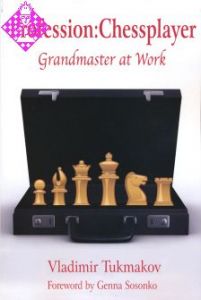 Profession: Chessplayer7,95 € Regular Price 24,95 €
Profession: Chessplayer7,95 € Regular Price 24,95 € -
 Oops! I Resigned Again!9,95 €
Oops! I Resigned Again!9,95 € -
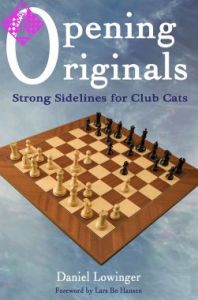 Opening Originals22,95 €
Opening Originals22,95 € -
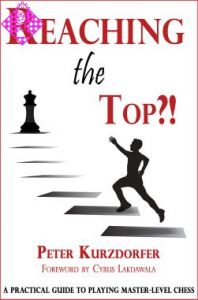 Reaching the Top24,95 €
Reaching the Top24,95 € -
 Oops! I Resigned One More Time!19,95 €
Oops! I Resigned One More Time!19,95 € -
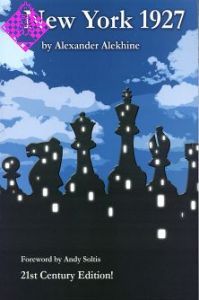 New York 192717,95 €
New York 192717,95 € -
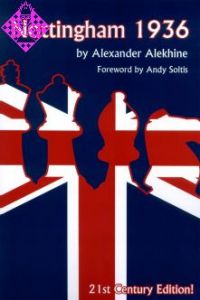 Nottingham 193624,95 €
Nottingham 193624,95 € - Mehr von Russell Enterprises

